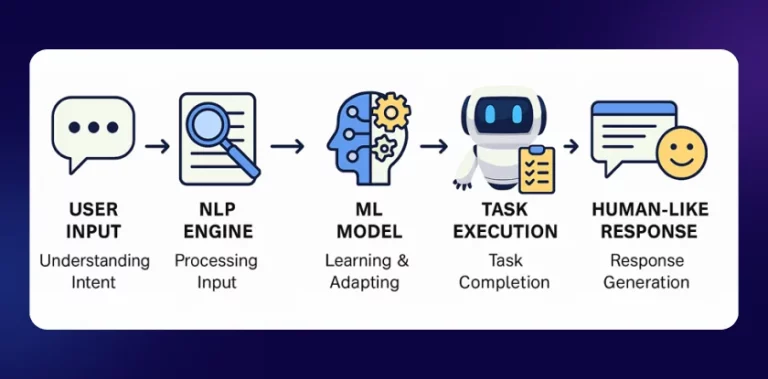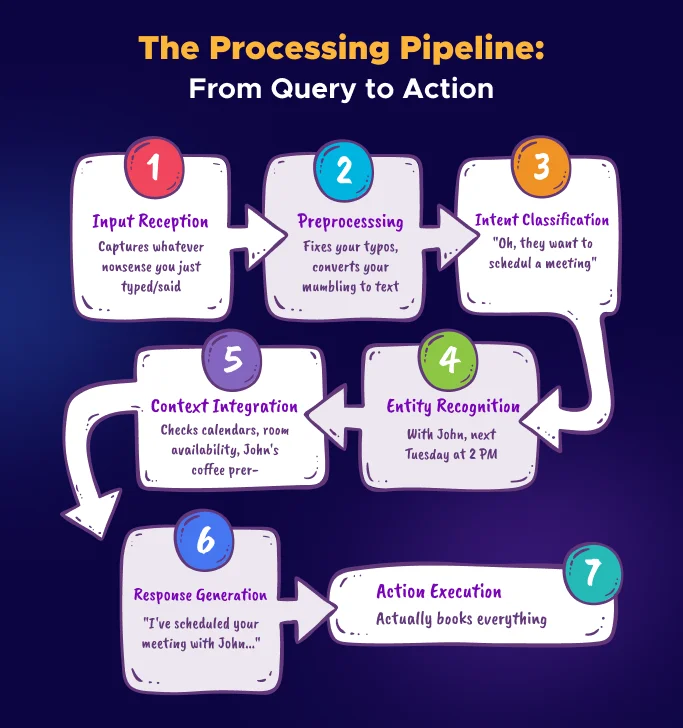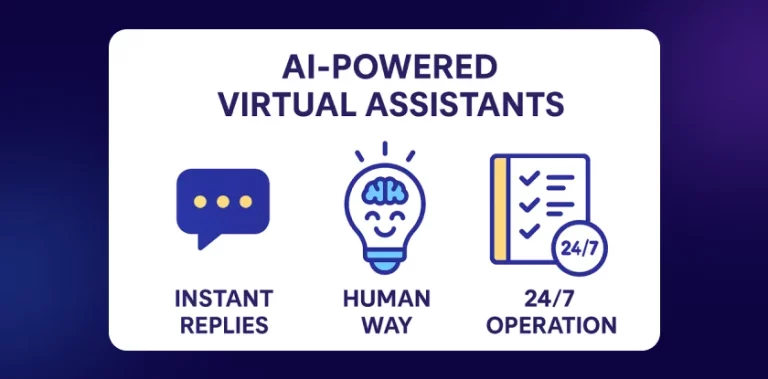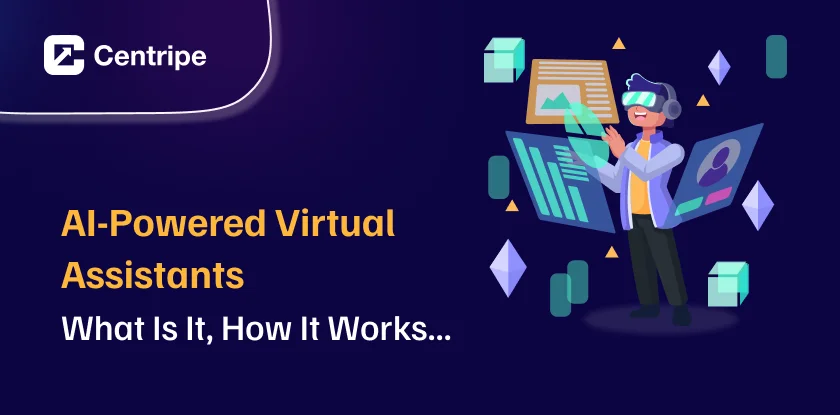According to Gartner, businesses using AI assistants are seeing productivity gains of up to 40%. While your competitors are moving ahead, do you really have spare time to do routine things manually?
Here’s the kicker: knowledge workers waste 2.5 hours daily just hunting for information. That’s like burning an entire workday every week.
Meanwhile, 67% of companies are stuck doing the same repetitive tasks over and over.
The AI chatbots are now smarter than ever. Instant replies, interacting humanely, solving problems faster, managing multiple customers 24/7, and they do so much more with ease.
From Marketing to data handling, from lead management to after sales service, these chatbots are nothing less than a miracle for businesses.
Tech Fact: As of 2025, Google Assistant leads global use with 39% share, followed by Amazon Alexa (36%) and Apple Siri (29%). Microsoft Cortana trails at 11%, with Samsung Bixby at 10%.
What Are AI-Powered Virtual Assistants?
The evolution from limits to limitless is something to appraise. AI powered virtual assistants have unlimited resources. They train themselves, keep track of everything, understand people.
These smart assistants work by reading your input, they figure out what you mean, and then use the knowledge to response accordingly.
What if you want to switch from one topic to another? For a human agent, it might take time but for these chatbots it’s very easy.
They solve the problems step by step and even learn your preferences over time. So that they always serve you better.
Customer service or personal scheduling, such kind of works have been automated with these task-oriented chatbot. See they do the work with expertise, the customers can’t even tell the difference if it is a machine or human.
How AI-Powered Virtual Assistants Work: The Technical Framework

Note: Over 70% of businesses are expected to integrate AI-driven customer support systems by 2025
1. Natural Language Processing (NLP)
- Intent Recognition: Figures out what you’re actually trying to do (even when you ramble)
- Entity Extraction: Pulls out the important bits from your word salad
- Sentiment Analysis: Knows when you’re about to lose it (and responds accordingly)
- Language Detection: Switches languages faster than my high school Spanish teacher
2. Machine Learning Algorithms
- Supervised Learning: You teach it, it learns (like training a really smart dog)
- Unsupervised Learning: It figures stuff out solo (kinda creepy, totally cool)
- Reinforcement Learning: Gets better through trial and error (like all of us)
- Transfer Learning: Takes skills from one area and applies them elsewhere
3. Large Language Models (LLMs)
- Contextual Understanding: Remembers that thing you mentioned 10 messages ago
- Content Generation: Writes responses that don’t sound like a robot had a stroke
- Reasoning Capabilities: Can actually think through problems (better than me before coffee)
- Knowledge Integration: Has access to more info than Wikipedia
Why This Matters?
All this tech wizardry creates AI assistants that actually understand what you need and give helpful responses. You get a digital helper that feels almost human, without needing to be a tech expert to use it effectively.
Explore more articles: How to Use E-commerce Chatbot
The Processing Pipeline: From Query to Action
Here’s what happens when you ask your smart assistant for something—it’s actually pretty fascinating:

Top AI virtual assistants are:
Siri
Siri is a built in automation assistant for iOS devices. It is known for voice commands and eco-system integration.
Alexa
Alexa is straight out of a sci-fi book. A versatile voice AI for smart homes and e-commerce.
Google Assistant
This one has changed the way we search on web, scheduling , and home automation.
ChatGPT
OpenAI’s conversational AI, widely used for writing, coding help, and answering complex queries creatively.
Microsoft Copilot
Microsoft’s AI assistant natively integrated with Microsoft 365, streamlining productivity and collaboration.
Jasper
A highly-regarded AI for content creation, tailoring copy and tone for businesses and marketing teams.
Aeri by Centripe
Aeri is Centripe’s smart CRM virtual assistant, automating tasks, analyzing data, and tracking sentiment effortlessly.
Bixby
Samsung’s native AI for Galaxy devices, offering strong device control and contextual responses.
Otter AI
Known for the transcription capability and meeting management, it provides a helping hand to professionals.
Cognigy
It is an enterprise grade AI chatbot, that is built for automating customer service interaction.
Workplace Productivity Advantages

Note: Companies using AI assistants report 40% faster task completion and 30% reduction in operational costs.
Business Process Automation
The reading through contracts and reports to pull out key information instantly, has become a cherry on cake for these smart bots. They even create summaries and present it in a understandable way.
One of the biggest advantage is that the customer service can run on autopilot, handling routine questions 24×7. Plus, they route complex issues to the right experts.
Team Collaboration Improvements
Communication flows smoothly when AI translates messages between team members, summarizes endless email threads, and creates project updates everyone can understand.
The flow of information becomes smooth. AI captures team expertise, already knows the right person for specific questions and creates training materials.
The next thing is project management. Virtual assistant keeps track of deadlines, identifies flaws and generates progress reports.
Real Impact on Your Workday
The time you get back is substantial, no more spending hours scheduling meetings or hunting through emails for attachments.
The stress you avoid is equally valuable, as you’ll never miss deadlines and can stop worrying about losing important documents.
Quality improvements happen naturally with consistent communication, fewer errors in routine tasks, and better decision-making with instant access to relevant information.
Case Study
McDonald’s AI Assistant Success Story
The Problem
McDonald’s managers were drowning in paperwork, spending almost half their time doing boring admin tasks like counting inventory and filling out safety forms.
With staff quitting constantly and more complex orders from delivery apps, managers had no time to actually manage or help customers.
The Solution
McDonald’s introduced a “Virtual AI Manager” – a smart digital assistant that works 24/7 in their restaurants.
This AI helper automatically handles daily paperwork, warns managers before equipment breaks down, and guides new employees through their tasks step-by-step, just like having an experienced manager always available.
The Results
Managers got their time back to focus on customers instead of paperwork. New employees learned faster with AI guidance, making fewer mistakes and needing less training.
Equipment broke down less often because the AI predicted problems early. The system handled busy periods and complex orders without breaking a sweat.
Why It Worked
The AI assistant solved real problems that every McDonald’s faced – too much paperwork, equipment failures, and undertrained staff. By automating the boring stuff, managers could do what they do best: run great restaurants and take care of customers.
Want to learn more? Check out this related blog:
Best Chatbots for Ecommerce: Top 6 Tools Compared
In Short
Conclusion
AI-powered virtual assistants have changed. They went from basic chatbots to true productivity partners. Now, they manage complex tasks and give you more time for creative work.
Companies like McDonald’s show that these tools work. They automate dull tasks, letting humans focus on what really matters.
Looking ahead, AI assistants will become even more sophisticated and affordable.
No matter if you lead a small team or a big company, the key question is not if you should use these tools. Instead, it’s about how fast you can enjoy better productivity and save costs.
